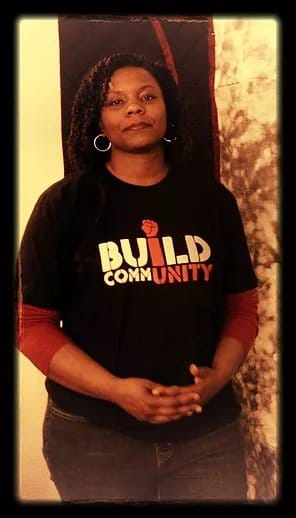
Artists Tackle Slavery, Lynching, And Sexual Violence In New Exhibit
Indianapolis collaborative artist LaShawnda Crowe Storm and Bloomington poet Abegunde tell the stories of women who suffered slavery, lynching, sexual violence, and other atrocities. For Storm, the work began in 2004 with a quilt that bluntly depicted one of the few known images of a woman who had been lynched—the piece was called “Becoming Laura Nelson,” and it kicked off a conversation with the community that she has continued since. In 2007, Storm partnered with Abegunde, who added writing to the mix. The pair have used the masquerade traditions of the Yoruba people of Nigeria to remember the women brought from Africa to the Americas as slaves. For instance, women Abegunde knew contributed the names of female ancestors who were enslaved for one of her poems, and audience members at their events have been asked to add the names of women they knew who were impacted by this history of violence.
Storm and Abegunde’s new exhibition, Keeper of My Mothers’ Dreams, opens this weekend at the Tube Factory Artspace with a bronze casting of the pelvis of an African American woman, several representations of the womb provided by other artists, and poetry readings recited in unison with the audience. Here, they collaborated on a discussion of their themes:
What conversation did you begin with “Becoming Laura Nelson”?
Storm: I’ve come from Africa and I’ve become this other being and this is the history that befell me here. It’s not just about lynching, it’s also about the genderedized violence that happens to women through lynching, which is sexual assault and other things.
How has it changed with the new exhibition?
S: We moved to: How do we reclaim all this? That’s what the new pieces in the series are. They bring together these two conversations that are on different ends of the spectrum. These pieces in many ways become the closure on the first conversation and how do we now create a space where one reclaims and rebirths the future that they want versus the one that has, in so many ways, historically opposed women.
Abegunde: Moving from “Laura Nelson,” all of these things have to do with the body. If you consider the body to be its own type of costume, it’s how we move between these costumes. The centerpiece is the pelvis LaShawnda cast. Think of the womb as the world, think of the womb as a point of origin. You get a sense of what it is to be on either side of history and finding a way for the participants, who are also creating representations of their own wombs, to go back to that birth and rebirth.
Are you responding to current racial tensions with your work?
S: I’m not. These events aren’t current; it’s just that they’ve now been brought to the forefront. Any time there is a perceived forward movement of people of color in our country, one way or another—here, we can point to Barack Obama, which made people think that we were living in a country that was not America—you should not be shocked. All you have to do is take a quick backtrack and look at the ’60s, look at the race riots of the ’20s and ’10s that led to the destruction of many black townships because people thought black people were getting ahead too much. I think this whole notion that somehow we’re at a racial crisis does disrespect to the complexity of the history. We’ve never not been in a scenario where we were at a racial crisis moment.
A: To think that we have been having this conversation and this fight for such a very long time in the world all over is a very frightening thing. To actually have to argue to be legally identified as human so that you can live, and to continue to have to prove to other people that you are human, what does that do to your psyche? That’s a really profound thing to think about, what that must do over centuries to people. You don’t really have to think too much about the contemporary situation and how one responds to it because in the response to history one responds to the contemporary.
Collaboration with the community has been an important aspect of these works. What does that look like?
S: I don’t always know what that looks like going into the process. As the project kind of births itself—because a lot of times as an artist, you’re more like a midwife—we have to think, How do we create space for community to be here? That’s not always the same.
A: For these particular projects, the community is always first and foremost because you can’t do the work around the community and talk about community healing without including them and having them take responsibility for part of that work.
What should people know before they go to the show?
S: The piece itself is the installation, but it is also the poetry, it is also the community interaction component. None can really live without the other because they were born and created together.
A: They are ancestral pieces, so they honor the ancestors. They’re very much grounded in the processes that you see and don’t see around ritual.
How do you hope the audience will be affected?
S: People are complex. These are complex histories. These are very difficult artworks that don’t necessarily—they’re really beautiful, but we don’t hold anything back about what we’re talking about here. What happens will happen.
A: The idea of hoping or having expectations beyond the fact that it gets done and that people come, that’s a little bit too much because everyone will have a different response to it.
Keeper of My Mothers’ Dreams runs through January 20 at Tube Factory Artspace (1125 S. Cruft St.).






